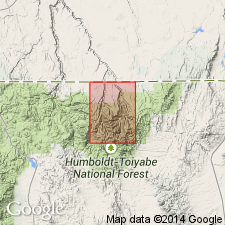
- Usage in publication:
-
- Meadow Fork formation*
- Modifications:
-
- Named
- Dominant lithology:
-
- Conglomerate
- Sandstone
- Tuff
- Shale
- AAPG geologic province:
-
- Great Basin province
Summary:
Pg. M7-M8, pI. 1 (geol. map). Meadow Fork formation. Chiefly tuffaceous and arkosic conglomerate with boulders as much as 5 feet in diameter. Thickness 150 to about 1,300 feet; base not exposed everywhere. At type locality conformably overlies Dead Horse tuff and is unconformably overlain by Danger Point tuff (new) and younger rocks. Cut by Seventy Six basalt (new). Age indeterminate but gradational contact with Dead Horse tuff and coarseness of conglomerate suggest that deposition required only short interval of time immediately following deposition of Dead Horse tuff. Age regarded as probably late Eocene. Age indicated as Miocene(?) on map explanation, but Eocene date seems preferable on basis of potassium-argon date of Dead Horse tuff. Adopted by the USGS.
Type locality: exposures along Meadow Fork of Copper Creek, in southwest corner of Jarbidge quadrangle, Elko Co., northeastern NV. Named from Meadow Fork. Most extensive exposures occur in Copper Basin, in southwest corner of quadrangle, and in Marys River Peak-Cougar Peak area, in south-central part of quadrangle. Also exposed at Bonanza Gulch, 2 mi south-southeast of town of Jarbidge.
Source: US geologic names lexicon (USGS Bull. 1350, p. 478); supplemental information from GNU records (USGS DDS-6; Denver GNULEX).
For more information, please contact Nancy Stamm, Geologic Names Committee Secretary.
Asterisk (*) indicates published by U.S. Geological Survey authors.
"No current usage" (†) implies that a name has been abandoned or has fallen into disuse. Former usage and, if known, replacement name given in parentheses ( ).
Slash (/) indicates name conflicts with nomenclatural guidelines (CSN, 1933; ACSN, 1961, 1970; NACSN, 1983, 2005, 2021). May be explained within brackets ([ ]).

